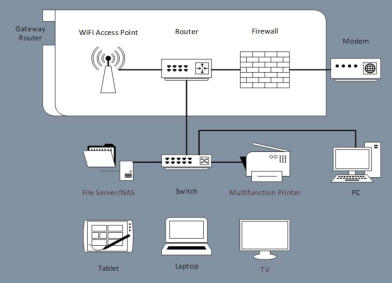


© Estwald ISI 2015 - 2025


Estwald’s
Information System Infrastructures

The Network
The figure to the right represents a typical home or office local
area network (LAN). It consists of clients (workstations, tablets,
laptops, TV, and phone), servers (file, database, web, application,
print), and network devices (router, switch, access point, modem,
bridge) both wired and wireless.
A device on the network connects to it using a network
interface cards (NIC). The most common of these are the Ethernet
NIC for wired devices and the Wave NIC for wireless devices. The
Institute of Electrical and Electronic Engineers (IEEE) 802 standard
covers local area network (LAN) and metropolitan area network
(MAN) network standards. For Ethernet IEEE 802.3 standards
apply and 802.11 standards apply to Wave (WiFi) technologies.
Standards, in general, are a twin edge sword. On one hand
devices from multiple manufacturers will work with each other so
long as they comply with the 802 standard. On the other hand, proprietary techniques used in some devices may provide
benefits not available under the standard but will only work with other devices from the same manufacturer using the same
proprietary technologies.
This leaves the consumer with a choice of embracing a standard with a multitude of manufacturers and perhaps a less
capable device or being tied to a single manufacturer with possibly a superior device.
















